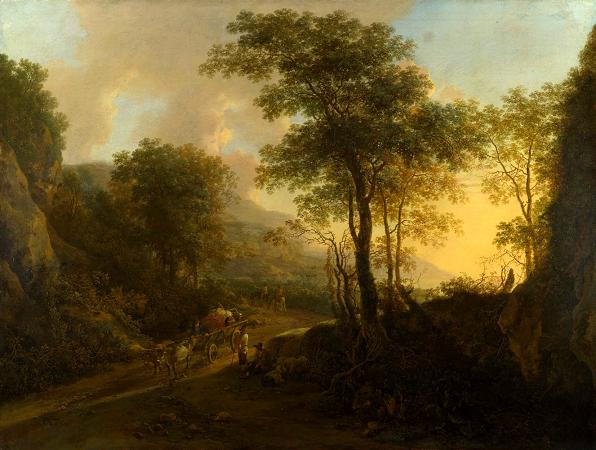Landscape with Road. A road is a thoroughfare, route, or way on land between two places that has been paved or otherwise improved to allow travel by foot or some form of conveyance, including a motor vehicle, cart, bicycle, or horse. Roads consist of one or two roadways, each with one or more lanes and any associated sidewalks and road verges. There is sometimes a bike path. Other names for roads include parkways, avenues, freeways, tollways, interstates, highways, or primary, secondary, and tertiary local roads. Historically many roads were simply recognizable routes without any formal construction or maintenance. The Organisation for Economic Co-operation and Development defines a road as a line of communication using a stabilized base other than rails or air strips open to public traffic, primarily for the use of road motor vehicles running on their own wheels, which includes bridges, tunnels, supporting structures, junctions, crossings, interchanges, and toll roads, but not cycle paths. The Eurostat, ITF and UNECE Glossary for Transport Statistics Illustrated defines a road as a Line of communication open to public traffic, primarily for the use of road motor vehicles, using a stabilized base other than rails or air strips. Included are paved roads and other roads with a stabilized base, e.g. gravel roads. Roads also cover streets, bridges, tunnels, supporting structures, junctions, crossings and interchanges. Toll roads are also included. Excluded are dedicated cycle lanes. The 1968 Vienna Convention on Road Traffic defines a road as the entire surface of any way or street open to public traffic. In urban areas roads may diverge through a city or village and be named as streets, serving a dual function as urban space easement and route. Modern roads are normally smoothed, paved, or otherwise prepared to allow easy travel. In the United Kingdom The Highway Code details rules for road users, but there is some ambiguity between the terms highway and road. For the purposes of the English law, Highways Act 1980, which covers England and Wales but not Scotland or Northern Ireland, road is any length of highway or of any other road to which the public has access, and includes bridges over which a road passes. This includes footpaths, bridleways and cycle tracks, and also road and driveways on private land and many car parks. Vehicle Excise Duty, a road use tax, is payable on some vehicles used on the public road. The definition of a road depends on the definition of a highway; there is no formal definition for a highway in the relevant Act. A 1984 ruling said the land over which a public right of way exists is known as a highway; and although most highways have been made up into roads, and most easements of way exist over footpaths, the presence or absence of a made road has nothing to do with the distinction. Another legal view is that while a highway historically included footpaths, bridleways, driftways, etc., it can now be used to mean those ways that allow the movement of motor-vehicles, and the term rights of way can be used to cover the wider usage. In the United States, laws distinguish between public roads, which are open to public use, and private roads, which are privately controlled. Maintenance is becoming an increasing problem in the United States. Between 1997 and 2018, the number of existing roads too bumpy to drive on compared to roads with decent surfaces has increased by 11%, mostly due to potholes that are not being properly addressed. Main article: History of road transport The assertion that the first pathways were the trails made by animals has not been universally accepted; in many cases animals do not follow constant paths. Some believe that some roads originated from following animal trails. The Icknield Way may examplify this type of road origination, where human and animal both selected the same natural line. By about 10,000 BC human travelers used rough roads/pathways. The world's oldest known paved road was constructed in Egypt some time between 2600 and 2200 BC. Stone-paved streets appear in the city of Ur in the Middle East dating back to 4000 BC. Corduroy roads are found dating to 4000 BC in Glastonbury, England. The Sweet Track, a timber track causeway in England, is one of the oldest engineered roads discovered and the oldest timber trackway discovered in Northern Europe.
more...














